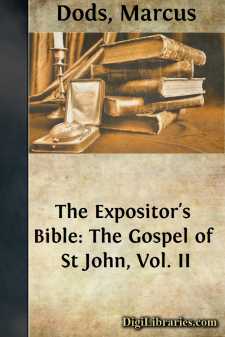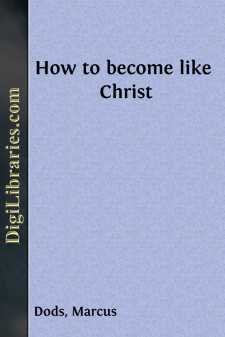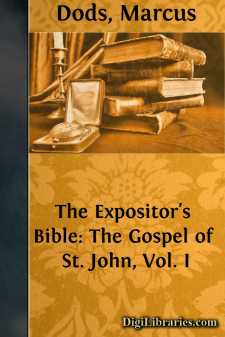Categories
- Antiques & Collectibles 13
- Architecture 36
- Art 48
- Bibles 22
- Biography & Autobiography 813
- Body, Mind & Spirit 142
- Business & Economics 28
- Children's Books 15
- Children's Fiction 12
- Computers 4
- Cooking 94
- Crafts & Hobbies 4
- Drama 346
- Education 46
- Family & Relationships 57
- Fiction 11828
- Games 19
- Gardening 17
- Health & Fitness 34
- History 1377
- House & Home 1
- Humor 147
- Juvenile Fiction 1873
- Juvenile Nonfiction 202
- Language Arts & Disciplines 88
- Law 16
- Literary Collections 686
- Literary Criticism 179
- Mathematics 13
- Medical 41
- Music 40
- Nature 179
- Non-Classifiable 1768
- Performing Arts 7
- Periodicals 1453
- Philosophy 64
- Photography 2
- Poetry 896
- Political Science 203
- Psychology 42
- Reference 154
- Religion 513
- Science 126
- Self-Help 84
- Social Science 81
- Sports & Recreation 34
- Study Aids 3
- Technology & Engineering 59
- Transportation 23
- Travel 463
- True Crime 29
The Expositor's Bible: The Gospel of St John, Vol. II
by: Marcus Dods
Description:
Excerpt
This twelfth chapter is the watershed of the Gospel. The self-manifestation of Jesus to the world is now ended; and from this point onwards to the close we have to do with the results of that manifestation. He hides Himself from the unbelieving, and allows their unbelief full scope; while He makes further disclosures to the faithful few. The whole Gospel is a systematic and wonderfully artistic exhibition of the manner in which the deeds, words, and claims of Jesus produced,—on the one hand, a growing belief and enthusiasm; on the other, a steadily hardening unbelief and hostility. In this chapter the culmination of these processes is carefully illustrated by three incidents. In the first of these incidents evidence is given that there was an intimate circle of friends in whose love Jesus was embalmed, and His work and memory insured against decay; while the very deed which had riveted the faith and affection of this intimate circle is shown to have brought the antagonism of His enemies to a head. In the second incident the writer shows that on the whole popular mind Jesus had made a profound impression, and that the instincts of the Jewish people acknowledged Him as King. In the third incident the influence He was destined to have and was already to some extent exerting beyond the bounds of Judaism is illustrated by the request of the Greeks that they might see Jesus.
In this first incident, then, is disclosed a devotedness of faith which cannot be surpassed, an attachment which is absolute; but here also we see that the hostility of avowed enemies has penetrated even the inner circle of the personal followers of Jesus, and that one of the chosen Twelve has so little faith or love that he can see no beauty and find no pleasure in any tribute paid to his Master. In this hour there meet a ripeness of love which suddenly reveals the permanent place which Jesus has won for Himself in the hearts of men, and a maturity of alienation which forebodes that His end cannot be far distant. In this beautiful incident, therefore, we turn a page in the gospel and come suddenly into the presence of Christ’s death. To this death He Himself freely alludes, because He sees that things are now ripe for it, that nothing short of His death will satisfy His enemies, while no further manifestation can give Him a more abiding place in the love of His friends. The chill, damp odour of the tomb first strikes upon the sense, mingling with and absorbed in the perfume of Mary’s ointment. If Jesus dies, He cannot be forgotten. He is embalmed in the love of such disciples.
On His way to Jerusalem for the last time Jesus reached Bethany “six days before the Passover”—that is to say, in all probability on the Friday evening previous to His death. It was natural that He should wish to spend His last Sabbath in the congenial and strengthening society of a family whose welcome and whose affection He could rely upon. In the little town of Bethany He had become popular, and since the raising of Lazarus He was regarded with marked veneration. Accordingly they made Him a feast, which, as Mark informs us, was given in the house of Simon the leper. Any gathering of His friends in Bethany must have been incomplete without Lazarus and his sisters. Each is present, and each contributes an appropriate addition to the feast. Martha serves; Lazarus, mute as he is throughout the whole story, bears witness by his presence as a living guest to the worthiness of Jesus; while Mary makes the day memorable by a characteristic action. Coming in, apparently after the guests had reclined at table, she broke an alabaster of very costly spikenard and anointed the feet of Jesus and wiped His feet with her hair.
This token of affection took the company by surprise. Lazarus and his sisters may have been in sufficiently good circumstances to admit of their making a substantial acknowledgment of their indebtedness to Jesus; and although this alabaster of ointment had cost as much as would keep a labouring man’s family for a year, this could not seem an excessive return to make for service so valuable as Jesus had rendered. It was the manner of the acknowledgment which took the company by surprise. Jesus was a poor man, and His very appearance may have suggested that there were other things He needed more urgently than such a gift as this. Had the family provided a home for Him or given Him the price of this ointment, no one would have uttered a remark....




